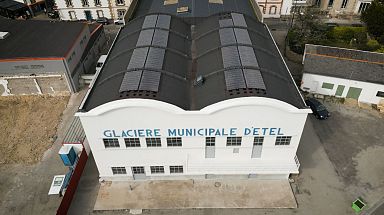The restoration of La Glacière in Étel in Brittany is both a conservation project and an investment in green technologies
Étel, a town in Brittany in France, is seeing its past being brought back to life.
It was once a big fishing port here and La Glacière - or the ice house - is a remnant of that heritage. Now it's being restored in a project that blends the town's history with the future of green Energy.
Local authorities intervene
The deputy mayor of Étel Étienne Pigeon displays a black and white photograph: "Here's what it looked like in 1960. After the restoration of the building, we really wanted to keep all of this, the double vaults, the balcony which was also important and which allowed the ice to be loaded. All the entrances and the doors have been kept."
Constructed in 1946, la Glacière d’Étel produced ice for the local port. Later the building was abandoned and fell into disrepair. Now the local authorities have bought it out to be restored.
"It's the last ice house in Morbihan, in Brittany," explains Étienne. "Until the 1950s there were 250 sailing boats that were used for fishing, mainly for tuna, and the tuna had to be preserved obviously, it needed ice, so without this building, there was no fishing. The main objective of our project is to welcome the public. People are attached to the building, they know it, they come from all over the department to see it."
Green energy
La Glacière already hosts exhibitions, this one's dedicated to maritime energy in Brittany. The use of green energy is a key part of the renovation project with a tidal turbine and a heat pump among the technologies used to bring the sea's energy to the building.
"We are going to use as a priority here at La Glacière all the sources of energy that we can find here nearby," explains Aurélien Bertin, advisor to La Glacière d’Étel Energy Project at VALOEN. "From the sea to begin with, we are going to use seawater for two things: the current will turn a tidal turbine propeller to produce electricity. And we'll also use the nature of seawater and its relatively constant temperature over the year for a seawater heat pump, which will allow us to recuperate calories to heat the building. The heat pump works like an inverted fridge if you like."
To capture the sun's energy, the curved roof is covered by innovative biodegradable and flexible solar panels designed in Nantes. Surplus energy will be shared with local municipal buildings.
La Glacière energy project received nearly €166,000 in European funding.
A new page of history
And the Viviers du Pradic fishmongers, with its ponds at the back of La Glacière, is a reminder of the era when this place was full of ice
"Étel was a symbol 50 years ago," says manager Jean-Charles Rimbault. "It is a city that has a history in terms of fish, and it was important for me to set up in a place that has a past and be able to write a page of history myself."
The inauguration of La Glacière d’Étel as a gateway to this picturesque region is expected by 2025.












